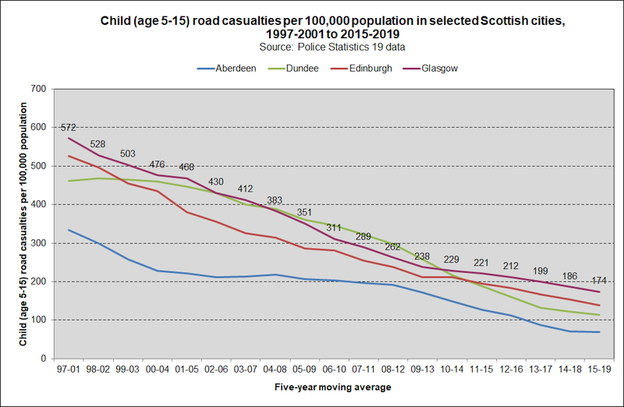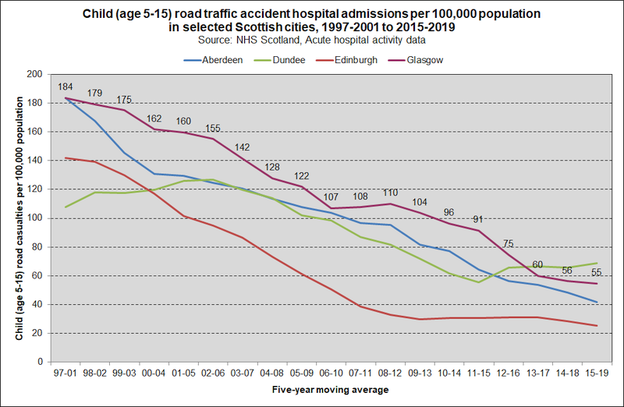Scottish cities
Child (age 5-15) road casualties in selected Scottish cities
Click on graph to enlarge
Between 1997-2001 and 2015-2019, the number of child road casualties per 100,000 in Glasgow has fallen dramatically, from 572 to 174, on average. This constitutes an approximate 70% reduction in the child casualty rate. Aberdeen has consistently had the lowest child casualty rate.
The casualty rates recorded by the police (via Stats 19) are higher than the rate of hospital admissions (shown below). This reflects the fact that road accident casualties admitted to hospital represent a subset of all road accident casualties.
Child (age 5-15) road traffic accident hospital admissions in selected Scottish cities
Click on graph to enlarge
Between 1997-2001 and 2012-2016, Glasgow had the highest rate of child road traffic accident hospital admissions among the four major Scottish cities, although in recent years Dundee has had a slightly higher rate. Since 1997-2001, Edinburgh has seen a dramatic reduction in the rate of child road casualty admissions, with its rate being less than half that of Glasgow's in the most recent time period (2015-2019).
Notes
The figures shown are based on two sources:
Stats 19 statistical returns: made by police forces, which cover all accidents in which a vehicle is involved that occur on roads (including footways) and result in personal injury, if they become known to the police. There could be many non-fatal injury accidents which are not reported by the public to the police, and are therefore not counted in these statistics. Further statistics on Stats 19 based road traffic accidents and casualties can be accessed from Transport Scotland publications.
Hospital admission data: These statistics are derived from data collected on discharges from non-obstetric and non-psychiatric acute hospitals (SMR01) in Scotland. The data are based on year of discharge. Relevant hospital episodes have been identified by admission type (emergency hospital admission: SMR01 admission type code 32 - Patient injury - road traffic accident) and by diagnosis (Pedestrian injured in transport accident (V01-V09), Pedal cyclist injured in transport accident (V10-V19), Motorcycle rider injured in transport accident (V20-V29), Car occupant injured in transport accident (V40-V49), Other (any other diagnosis codes recorded)).
Additional Resources
-
ResourceThursday, 6 December 2012
Going to Gothenburg: Reflections on a Study Visit
-
ResourceWednesday, 18 May 2011
Hands Up Scotland 2010
Results from the largest national dataset to look at mode of travel to school across Scotland -
ResourceFriday, 1 October 2010
Moving in the right direction?
Findings from a review of transport policy in Scotland -
ResourceSaturday, 21 August 2010
Active Travel - Video
Qualitative research has been undertaken in order to better understand how and why people currently travel as they do and to explore the scope for encouraging growth in alternatives to car travel. -
ResourceTuesday, 1 September 2009
Attitudes toward active travel in Glasgow
Findings from a qualitative research project exploring how and why people travel in and around Glasgow -
ResourceThursday, 1 November 2007
How can transport contribute to public health?
A briefing paper discussing the evidence regarding the potential of transport to improve health, reduce inequalities and improve sustainability









